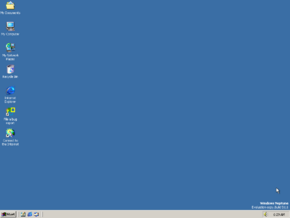Build list legend
Non-existent page
| Version of Microsoft Windows | |
 | |
 | |
| OS family | Windows NT |
|---|---|
| Version | 5.50 |
| Codename | Neptune |
| Architecture | x86 |
| Replaces | |
| Windows 2000 Windows 98 Windows Me | |
Neptune was the codename for a canceled version of Microsoft Windows scheduled for release during the year 2000, which would have been the first consumer version of Windows based on the existing Windows NT codebase. The operating system was originally intended to succeed Windows 98, although this later shifted to Windows Me due to delays.
Major user experience changes were planned to ship with Neptune, including the Activity Centers – a new task-based user interface that featured individual "pages" focusing on daily tasks with facilities that include (but are not limited to) browsing the Internet, communication, document management and entertainment. User management was also improved in Neptune with the introduction of several new user types as well as a dedicated full-screen user interface. The new interfaces were primarily implemented using Internet Explorer's web technology, often using the then-new Mars framework. A key focus of the Neptune project was to experiment with user experiences that did not require manually saving previous work; some of this effort is visible in the only available build, which enables hibernation by default and requires the user to take extra steps to fully shut down the device.
A new Help and Support system was additionally introduced as part of Neptune, providing a consumer-oriented centralized hub that offers documentation for most Windows features as well as dedicated troubleshooters for common issues like system crashes.
Internal additions and changes to Windows functionalities were also introduced in the project such as application caching, simplified networking utilities, driver resource management, and extended support for varying imaging hardware such as scanners and digital cameras. The Profile-Assisted Boot Accelerator, a feature that captures the system state immediately after a normal boot and restores it during subsequent boots, was also introduced.
The project was worked on throughout 1999 before being ultimately scrapped in January 2000, as the Neptune team merged with another team focused on the Odyssey project, a business-oriented successor of Windows 2000. The merging of both teams resulted in the formation of a new project codenamed Whistler, which ultimately evolved into Windows XP. Many of the project objectives later inspired and/or laid the groundwork for a number of new features in the versions that followed, with Windows XP introducing an evolved form of Neptune's new Start menu design as well parts of the task-based user interface.
The touch-oriented Metro design language introduced as part of Windows 8 also shared many common goals with the Neptune project, including the Activity Centers' focus on typography as well as dedicated full-screen applications for common tasks. Windows 8 also introduced hybrid boot, a functionality that takes advantage of hibernation to capture the initial states of necessary system applications and boot drivers, largely similar in principle to the Boot Accelerator feature that would have been included as part of Neptune.
Neptune concept art/UI mockups from a 1998 Microsoft presentation:
Outlook Express UI mockup
A minor update to Neptune codenamed "Triton" is mentioned in internal Microsoft documents from 1998, which was planned to be released in March 2001, a year after the initial release of Neptune. According to the documents, Neptune would also receive several Service Pack updates while Triton would have been in development.[1]
Build list legend
Although only build 5111.1 is currently available, evidence for other builds exist mostly as part of file versions sourced from varying Windows Me builds.